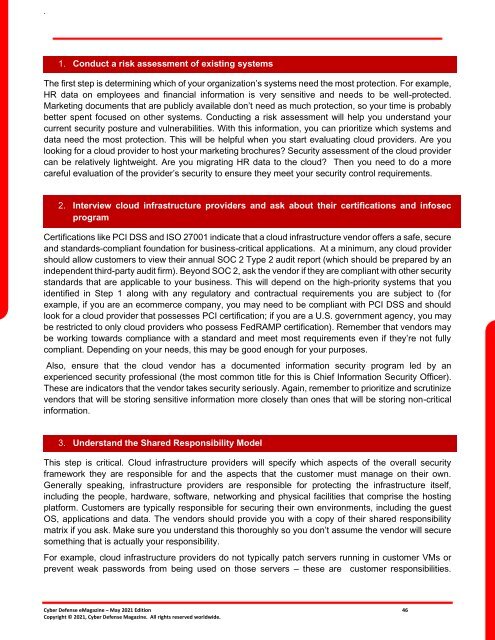Cyber Defense eMagazine May 2021 Edition
Cyber Defense eMagazine May 2021 Edition for 2021 #CDM #CYBERDEFENSEMAG @CyberDefenseMag by @Miliefsky a world-renowned cyber security expert and the Publisher of Cyber Defense Magazine as part of the Cyber Defense Media Group as well as Yan Ross, US Editor-in-Chief, Pieruligi Paganini, Co-founder & International Editor-in-Chief, Stevin Miliefsky, President and many more writers, partners and supporters who make this an awesome publication! Thank you all and to our readers! OSINT ROCKS! #CDM #CDMG #OSINT #CYBERSECURITY #INFOSEC #BEST #PRACTICES #TIPS #TECHNIQUES
Cyber Defense eMagazine May 2021 Edition for 2021 #CDM #CYBERDEFENSEMAG @CyberDefenseMag by @Miliefsky a world-renowned cyber security expert and the Publisher of Cyber Defense Magazine as part of the Cyber Defense Media Group as well as Yan Ross, US Editor-in-Chief, Pieruligi Paganini, Co-founder & International Editor-in-Chief, Stevin Miliefsky, President and many more writers, partners and supporters who make this an awesome publication! Thank you all and to our readers! OSINT ROCKS! #CDM #CDMG #OSINT #CYBERSECURITY #INFOSEC #BEST #PRACTICES #TIPS #TECHNIQUES
Create successful ePaper yourself
Turn your PDF publications into a flip-book with our unique Google optimized e-Paper software.
`<br />
1. Conduct a risk assessment of existing systems<br />
The first step is determining which of your organization’s systems need the most protection. For example,<br />
HR data on employees and financial information is very sensitive and needs to be well-protected.<br />
Marketing documents that are publicly available don’t need as much protection, so your time is probably<br />
better spent focused on other systems. Conducting a risk assessment will help you understand your<br />
current security posture and vulnerabilities. With this information, you can prioritize which systems and<br />
data need the most protection. This will be helpful when you start evaluating cloud providers. Are you<br />
looking for a cloud provider to host your marketing brochures? Security assessment of the cloud provider<br />
can be relatively lightweight. Are you migrating HR data to the cloud? Then you need to do a more<br />
careful evaluation of the provider’s security to ensure they meet your security control requirements.<br />
2. Interview cloud infrastructure providers and ask about their certifications and infosec<br />
program<br />
Certifications like PCI DSS and ISO 27001 indicate that a cloud infrastructure vendor offers a safe, secure<br />
and standards-compliant foundation for business-critical applications. At a minimum, any cloud provider<br />
should allow customers to view their annual SOC 2 Type 2 audit report (which should be prepared by an<br />
independent third-party audit firm). Beyond SOC 2, ask the vendor if they are compliant with other security<br />
standards that are applicable to your business. This will depend on the high-priority systems that you<br />
identified in Step 1 along with any regulatory and contractual requirements you are subject to (for<br />
example, if you are an ecommerce company, you may need to be compliant with PCI DSS and should<br />
look for a cloud provider that possesses PCI certification; if you are a U.S. government agency, you may<br />
be restricted to only cloud providers who possess FedRAMP certification). Remember that vendors may<br />
be working towards compliance with a standard and meet most requirements even if they’re not fully<br />
compliant. Depending on your needs, this may be good enough for your purposes.<br />
Also, ensure that the cloud vendor has a documented information security program led by an<br />
experienced security professional (the most common title for this is Chief Information Security Officer).<br />
These are indicators that the vendor takes security seriously. Again, remember to prioritize and scrutinize<br />
vendors that will be storing sensitive information more closely than ones that will be storing non-critical<br />
information.<br />
3. Understand the Shared Responsibility Model<br />
This step is critical. Cloud infrastructure providers will specify which aspects of the overall security<br />
framework they are responsible for and the aspects that the customer must manage on their own.<br />
Generally speaking, infrastructure providers are responsible for protecting the infrastructure itself,<br />
including the people, hardware, software, networking and physical facilities that comprise the hosting<br />
platform. Customers are typically responsible for securing their own environments, including the guest<br />
OS, applications and data. The vendors should provide you with a copy of their shared responsibility<br />
matrix if you ask. Make sure you understand this thoroughly so you don’t assume the vendor will secure<br />
something that is actually your responsibility.<br />
For example, cloud infrastructure providers do not typically patch servers running in customer VMs or<br />
prevent weak passwords from being used on those servers – these are customer responsibilities.<br />
<strong>Cyber</strong> <strong>Defense</strong> <strong>eMagazine</strong> – <strong>May</strong> <strong>2021</strong> <strong>Edition</strong> 46<br />
Copyright © <strong>2021</strong>, <strong>Cyber</strong> <strong>Defense</strong> Magazine. All rights reserved worldwide.


















